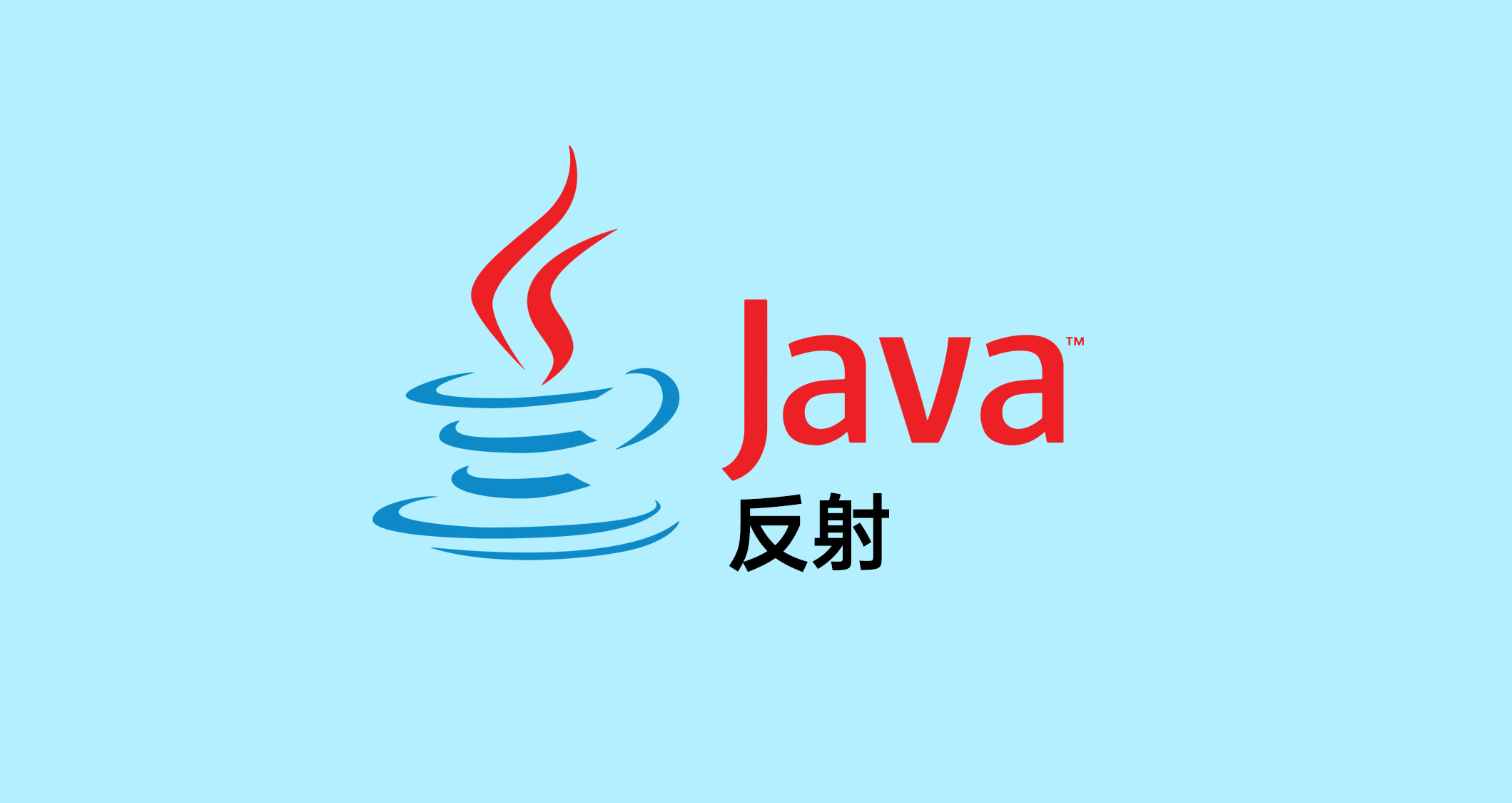反射Reflection
Reflection中文为反射、影子,读音为rəˈflekSH(ə)n,是动态语言的关键,在程序执行期间,可以通过反射的API获取类的内部信息,并且能够直接操作任意对象的内部方法、属性
在加载完类之后,在堆中产生了一个Class类型的对象,一个类只有一个Class对象,这个对象包含完整的类的结构信息,可以通过这个对象查看类的结构,所以被称为反射(Reflection)
反射提供的功能:
- 运行时,判断任意一个对象所属的类
- 运行时,构造任意一个类的对象
- 运行时,判断任意一个类所具有的成员变量和方法
- 运行时,获取泛型信息
- 运行时,调用任意一个类的成员变量和方法
- 运行时,处理任何注解
- 生成动态代理
API主要是在java.lang.reflect.下
Class类是用来描述类的类
在反射之前一个类外只能调用另一个类的非私有的方法、属性,可以通过反射调用一个其他类的私有属性和方法
每个类在运行时,都可以看作是Class类的一个实例
Class实例
获取Class实例的方式有4种,分别是:
-
调用运行时的属性:
类名.class返回Class类型,Class类是有泛型的,可以通过Class<类名> 变量名 = 类名.class;
-
通过运行时类的对象获取:首先要有一个要获取Class实例的类的实例,调用
实例.getClass()方法来获取,由Object类所定义 -
调用
Class类中的静态方法:Class.forName(类的路径字符串),字符串中要包含类所在的包,会抛出异常,需要try-catch环绕 -
使用类的加载器:
-
首先获取当前类中已经加载的类
-
ClassLoader 变量名1 = 当前的类名.class.getClassLoader();
-
-
再从已经加载的类中加载需要的类的实例
-
Class 变量名2 = 变量名1.loadClass("需要加载的类名");
-
-
以上方法获取的都是同一个实例,通过==可以判断出时true
加载到内存的运行时类会在内存中缓存一段时间,再此时间内,可以通过不同的方式获取这个类,以上就是不同的方式

通过反射创建对象
- 首先要有一个Class实例
- 调用Class实例中的
.newInstance()方法,该方法返回泛型(取决于上一步锁定义的Class实例传递给泛型的类型)
使用该方法进行创建时,需保证有一个空参构造器,并且访问权限不能是私有的
public class ReflectionTest {
public static void main(String[] args) throws ClassNotFoundException, InstantiationException, IllegalAccessException {
Class<Cat> c = Cat.class;
Cat cat2 = c.newInstance();
System.out.println(cat2);
}
}
class Cat {
private String name;
private int old, weight;
public Cat(String name, int old, int weight) {
this.name = name;
this.old = old;
this.weight = weight;
System.out.println("非私有的构造器");
}
private Cat(String name){
this.name = name;
System.out.println("私有的构造器");
}
public Cat(){
}
@Override
public String toString() {
return "Cat{" +
"name='" + name + '\'' +
", old=" + old +
", weight=" + weight +
'}';
}
}
获取类中的属性
- 创建一个Class实例
- 调用实例中的
.getFields(),返回Field[]类型,中文为领域,读音为fēld
可以使用循环遍历输出数组内容,只能获取到父类以及本身的public属性
若调用实例中的.getDeclaredFields(),则返回该类中所有的属性(不包含父类),无论权限是怎么样的,Declared,中文声明的、宣布、公告的、公然的,读音为dəˈklerd
Field类
在返回的Field类型中,有直接获取的该类型的权限的方法,.getModifiers(),返回一个整数,modifiers,中文为修饰符,读音为ˈmädəˌfī(ə)r,通过.getName()方法获取方法名
可以使用.getType()获取数据类型 返回Class类型,但当类型为一个类时,输出时显示class 包名类名,可以再调用.getName()隐藏掉Class
//比方说String类型会显示 class java.lang.String
//隐藏之后显示 class java.lang.String
for(Field f : fields){
System.out.println(Modifier.toString(f.getModifiers()));
System.out.println(f.getType());//类时会显示class
}
for(Field f : fields){
System.out.println(Modifier.toString(f.getModifiers()));
System.out.println(f.getType().getName().getName());//隐藏class
}
Modifier类
Modifier类中有中有许多静态方法,其中Modifier.toString(int x)可将上述的getModifiers()方法中所获得的整数翻译为String类型,也可以用Modifier.isXXX(int x)获取是否为某个权限,返回布尔类型
public static void main(String[] args) throws ClassNotFoundException, InstantiationException, IllegalAccessException {
Class<Cat> c = Cat.class;
Field[] fields = c.getDeclaredFields();
for(Field f : fields){
System.out.println(Modifier.toString(f.getModifiers()));
}
}
}
获取类中的方法
- 创建一个Class实例
- 调用实例的
.getMethods()获取父类以及本类的公共方法,.getDeclaredMethods()获取本类的所有方法- 返回
Method[]方法 - 可以在
Method类型中通过.getName()方法获取方法名
- 返回
- 获取方法声明的注解:
- 首先要获取方法的属性
- 调用
.Annotations()方法进行获取,返回Annotation[]
- 获取权限修饰符:
- 与获取类中属性的权限修饰符的方法相同
- 调用
Method数组中元素的.getModifiers()方法,获得一个整型数字 - 再使用
Modifier.toString(int x)进行翻译 - 即
System.out.println(Modifier.toString(m.getModifiers()));
- 获取方法的返回值类型
.getReturnType()方法
- 获取方法名
.getName()
- 获取方法的形式参数的类型:
.getParameterTypes(),返回Class[],获取方法的形式参数的类型- parameter中文为参数,读音为
pəˈramədər
- 获取方法可能抛出的异常:
.getExceptionTypes(),返回Class[],直接进行输出会显示class字符,跟前边一样,使用.getName(),不会显示class
获取类中的构造器
- 获取class实例
- 使用实例调用
.getConstructors()方法,返回Constructor[]类型,获取当前类中的public权限的构造器- constructor中文为构造器,读音````kənˈstrəktər```
- 使用实例调用
.getDeclaredConstructors(),返回Constructor[]类型,获取当前类中的所有构造器
获取运行时类的父类
- 获取一个class实例
- 获取这个class实例的父类:
- 调用
.getSuperClass(),返回Class类型
- 调用
获取带有泛型的父类
.getGenericSuperClass(),返回Type类型
获取带有泛型的父类的泛型

获取运行时类实现的接口
调用.getInterfaces()方法,返回Class[]
获取运行时类的包
调用.getPackage(),返回Package类型
public static void main(String[] args) throws ClassNotFoundException, InstantiationException, IllegalAccessException {
Class cat = Class.forName("Animal.Cat");
Package aPackage = cat.getPackage();
System.out.println(aPackage);
}

调用运行时类的指定结构
调用指定的属性、方法、构造器
需要保证有一个实例化的Class,并且创建了一个运行时类的对象
属性
获取指定的属性
会抛出异常,因为不能确保有这个属性
.getField(String name)方法,获取权限为private的属性,返回Field类型
.getDeclaredField(String name)方法,返回Field类型
设置属性的值
- 要有一个实例化的Class
- 创建一个运行时类的对象
- 调用
.getField(String name)方法或者.getDeclaredField(String name)方法进行获取属性- 调用获取到的属性的
.set(对象, 值)方法进行设置值 - 获取一个对象中这个属性的值:
获取到的属性.get(对象),返回Object类型,需要时可以进行强制类型转换 - 对于私有的属性,可以通过
.getDeclared()获取到属性,但不能直接使用set方法进行赋值,会抛出非法访问的异常,默认情况下不允许修改私有属性的值,若想使用set方法赋值,则必须要调用获取到的属性.setAccessible(true)的方法 将当前属性设置为可访问的,中文为设置无障碍
- 调用获取到的属性的
public class ReflectionTest {
public static void main(String[] args) throws Exception {
//要有一个实例化的Class
Class cat = Class.forName("Animal.Cat");
//创建一个运行时类的对象
Cat c = (Cat) cat.newInstance();
//获取特定的属性
Field gggg = cat.getField("gggg");
//设置值
gggg.set(c, 11);
//获取这个属性在一个对象中的值
System.out.println(gggg.get(c));
//获取私有的属性
Field name = cat.getDeclaredField("name");
//设置当前属性是可访问的
name.setAccessible(true);
//设置值
name.set(c, "hello");
//获取这个属性在一个对象中的值
System.out.println(name.get(c));
}
}
class Cat implements Serializable {
private String name;
private int old, weight;
public int gggg;
public Cat(String name, int old, int weight) {
this.name = name;
this.old = old;
this.weight = weight;
System.out.println("非私有的构造器");
}
private Cat(String name) {
this.name = name;
System.out.println("私有的构造器");
}
public Cat() {
}
@Override
public String toString() {
return "Cat{" +
"name='" + name + '\'' +
", old=" + old +
", weight=" + weight +
'}';
}
private void test(int x) {
System.out.println("我是隐藏的属性");
}
public void test2() throws Exception, RuntimeException {
}
public int getGggg() {
return gggg;
}
}
调用运行时类的指定方法
非静态的必须要有一个运行时类的对象
非静态:
-
要有一个实例化的Class
-
创建一个运行时类的对象
-
调用
实例化的Class.getMethod(String name, 可变形参),实例化的Class.getDeclaredMethod(String name, 可变形参),返回Method类型-
因为一个方法可能会有多个重载,所以需要指定该方法是哪个,因此要在可变形参中指明,格式为
类型.class -
例如
class a{ public void a(int x){ } public void a(int x, String x){ } } class b{ public static void main(String[] args){ Class cla = b.Class; Method a1 = cla.getMethod("a", int.class);//代表第二行的方法 Method a2 = cla.getMethod("a", int.class, String a);//代表第五行的方法 } }
-
-
调用方法:调用
获取到方法.invoke(对象, 可变参数的值),可变参数为上边各个参数的值,invoke中文为调用,读音为inˈvōk,该方法返回值为Object类型(如果没有,返回null),该方法的返回值为类中调用的方法的返回值-
对于私有的方法,仍然需要通过
.setAccessible(true)才可以访问 -
public class ReflectionTest { public static void main(String[] args) throws Exception { //实例化class类 Class cat = Class.forName("Animal.Cat"); //创建对象 Cat c = (Cat) cat.newInstance(); //获取指定的方法 Method test2_1 = cat.getDeclaredMethod("test2", int.class, String.class); //调用方法 test2_1.invoke(c, 2, "cat"); //获取指定的方法 Method test2_2 = cat.getDeclaredMethod("test2", int.class); //调用方法 test2_2.invoke(c, 2); //私有的方法 Method test = cat.getDeclaredMethod("test"); //设置当前方法是可访问的 test.setAccessible(true); //调用方法 test.invoke(c); } } class Cat implements Serializable { private String name; private int old, weight; public int gggg; public Cat(String name, int old, int weight) { this.name = name; this.old = old; this.weight = weight; System.out.println("非私有的构造器"); } private Cat(String name) { this.name = name; System.out.println("私有的构造器"); } public Cat() { } @Override public String toString() { return "Cat{" + "name='" + name + '\'' + ", old=" + old + ", weight=" + weight + '}'; } private void test() { System.out.println("我是隐藏的方法"); } public void test2(int x){ System.out.println("我是公共的方法" + x); } public void test2(int x, String name){ System.out.println("我是公共的方法" + x + name); } public void test2(){ System.out.println("公共方法"); } public int getGggg() { return gggg; } }
-
静态方法:
-
要有一个实例化的Class
-
无需创建一个运行时类的对象
-
调用
实例化的Class.getMethod(String name, 可变形参),实例化的Class.getDeclaredMethod(String name, 可变形参),返回Method类型- 因为一个方法可能会有多个重载,所以需要指定该方法是哪个,因此要在可变形参中指明,格式为
类型.class - 调用时可以使用
获取到方法.invoke(对象, 可变参数的值),其中对象可以写为null,即获取到方法.invoke(null, 可变参数的值) - 对于私有的方法,仍然需要通过
.setAccessible(true)才可以访问
- 因为一个方法可能会有多个重载,所以需要指定该方法是哪个,因此要在可变形参中指明,格式为
//静态方法
Method t1 = cat.getMethod("t1", int.class);
t1.invoke(null, 8);
Method t2 = cat.getDeclaredMethod("t2");
t2.setAccessible(true);
t2.invoke(null);
class Cat{
public static void t1(int x){
System.out.println("公共的静态方法" + x);
}
private static void t2(){
System.out.println("私有的静态方法");
}
}
静态变量/属性
可以参考静态方法,可以在对象的位置写null
调用运行时类的构造器
- 要有一个实例化的Class
- 创建一个运行时类的对象
- 调用
实例化的Class.getConstructor(可变形参),实例化的Class.getDeclaredConstructor(可变形参),返回Constructor类型,可变形参为构造器的参数列表- 对于私有的构造器,仍然需要通过
.setAccessible(true)才可以访问 - 创建对象:使用
获取到Constructor类型的构造器.newInstance(参数)进行创建对象,返回Object,但也需要强制类型转换
- 对于私有的构造器,仍然需要通过
public class ReflectionTest {
public static void main(String[] args) throws Exception {
//实例化class
Class cat = Class.forName("Animal.Cat");
//获取指定的构造器
Constructor constructor = cat.getConstructor(String.class, int.class, int.class);
//创建对象,
Cat c = (Cat) constructor.newInstance("cat", 11, 22);
System.out.println(c);
//私有构造器
Constructor constructor2 = cat.getDeclaredConstructor(String.class);
//设置私有构造器可以访问
constructor2.setAccessible(true);
//创建对象
Cat c2 = (Cat)constructor2.newInstance("cat2");
System.out.println(c2);
}
}
class Cat implements Serializable {
private String name;
private int old, weight;
public int gggg;
public Cat(String name, int old, int weight) {
this.name = name;
this.old = old;
this.weight = weight;
System.out.println("非私有的构造器");
}
private Cat(String name) {
this.name = name;
System.out.println("私有的构造器");
}
public Cat() {
}
}
动态代理
反射的应用,是一种设计模式
Q.E.D.






